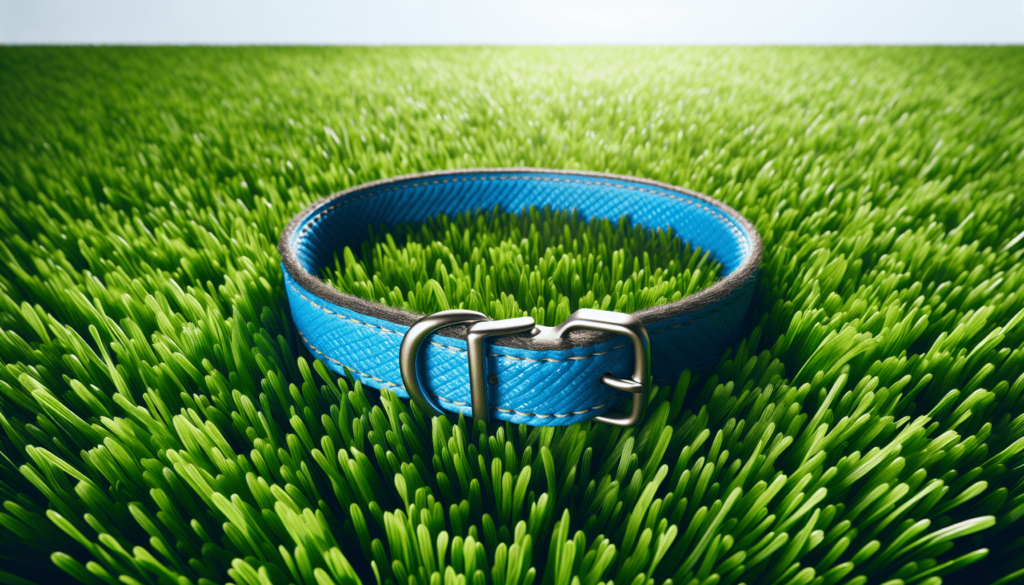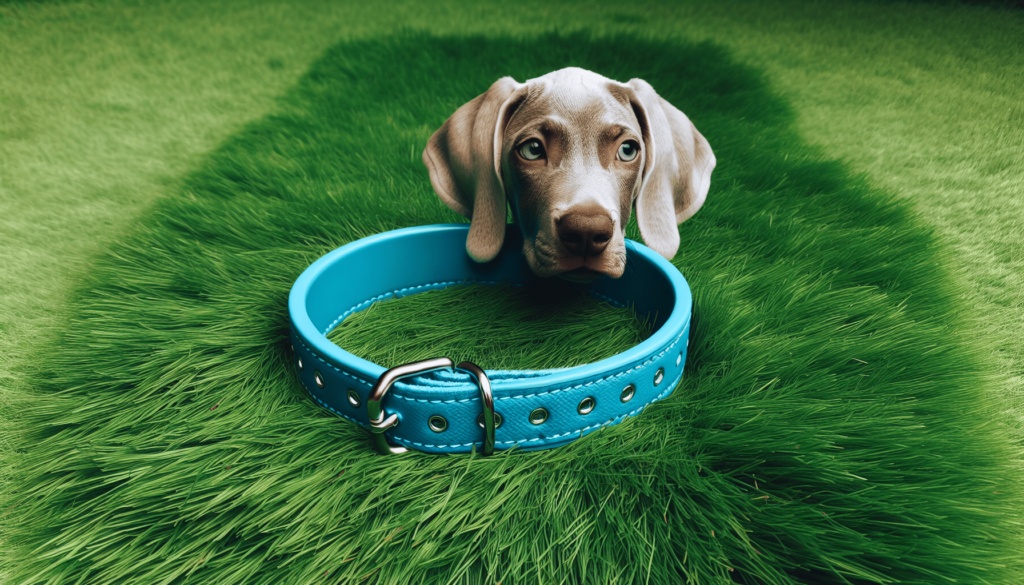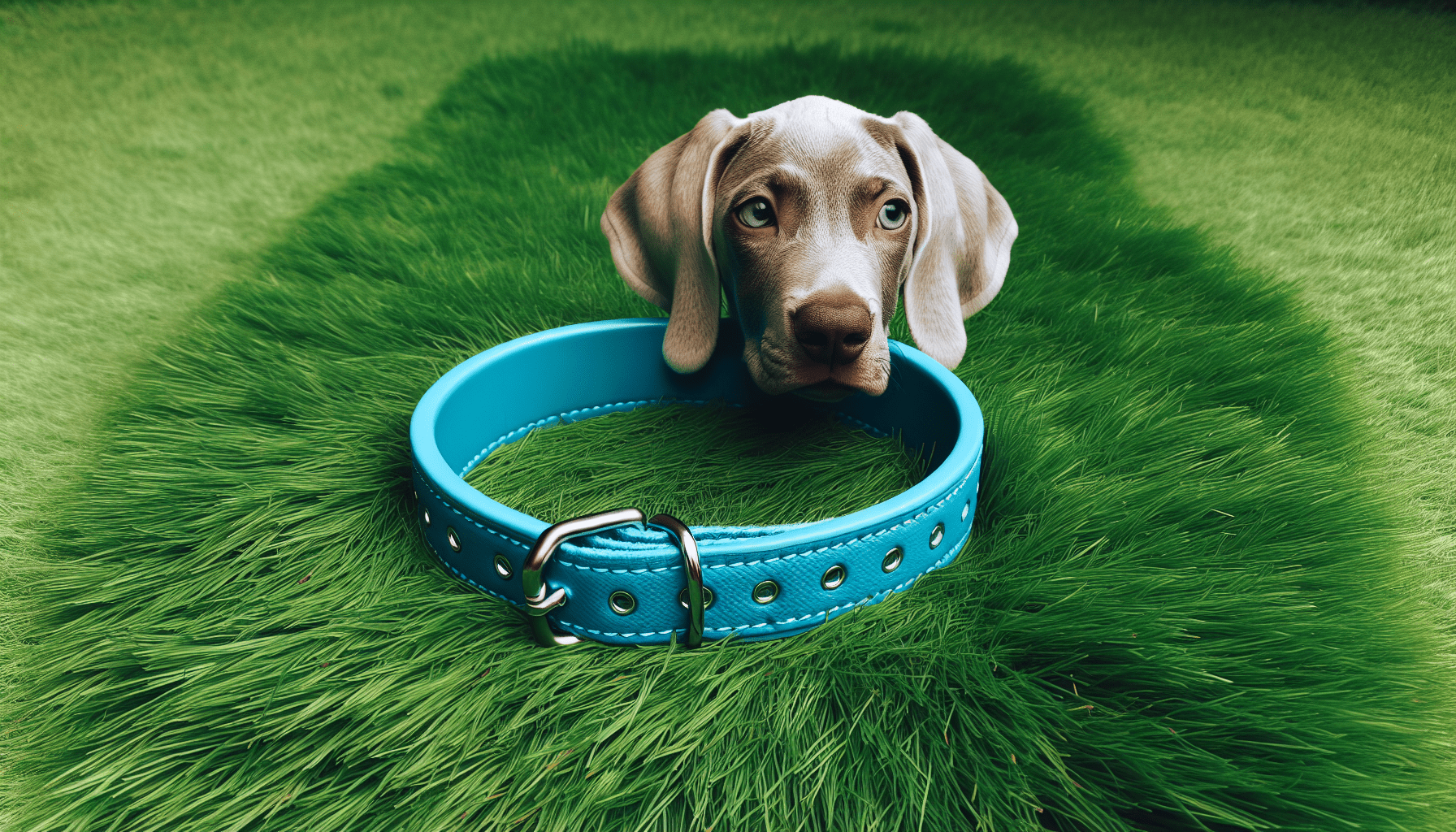So, you’ve just brought home a delightful Weimaraner puppy, and now you’re faced with the delightful task of toilet training them. Fear not! In this ultimate guide, you’ll discover effective techniques and strategies to help make this process a breeze. From establishing a routine to recognizing their signals, we’ll cover everything you need to know to successfully toilet train your Weimaraner puppy. Let’s jump right in!

Understanding the Weimaraner Breed
Weimaraners are a unique and distinctive breed known for their striking silver-gray coats and friendly personalities. They are energetic and intelligent dogs, making them excellent companions for active individuals and families. However, like any other breed, Weimaraner puppies require proper toilet training to become well-mannered and well-adjusted adult dogs. By understanding the characteristics of Weimaraner puppies and the importance of toilet training, you can set your furry friend up for success.
Characteristics of Weimaraner Puppies
Weimaraner puppies are highly intelligent and eager to please, which makes them relatively easy to train. However, they also have a ton of energy and a strong desire to explore their surroundings. This can sometimes lead to accidents indoors if they are not properly trained. Additionally, Weimaraners are known to have sensitive stomachs, which can lead to more frequent bathroom breaks. It’s important to recognize these characteristics when starting toilet training and tailor your approach accordingly.
Importance of Toilet Training for Weimaraners
Toilet training is crucial for Weimaraners to become well-adjusted members of your household. A well-trained Weimaraner will understand where and when they should relieve themselves, preventing accidents and providing peace of mind for both you and your pup. Additionally, proper toilet training sets the foundation for other obedience commands and helps strengthen the bond between you and your furry friend. With patience and consistency, you can successfully toilet train your Weimaraner puppy and enjoy a clean and happy home together.
Preparing for Toilet Training
Before diving into toilet training, it’s important to set yourself and your Weimaraner puppy up for success. Here are some essential steps to take before embarking on the toilet training journey:
Establishing a Designated Toilet Area
Toilet training becomes easier when your Weimaraner knows exactly where they should go to relieve themselves. Choose a specific area in your yard or a designated spot outside your home where you want your pup to do their business. This consistency helps them understand the proper location for bathroom breaks and also aids in minimizing future accidents indoors.
Choosing the Right Training Supplies
Investing in the right training supplies will make the toilet training process smoother for both you and your pup. Purchase a sturdy leash, poop bags, and cleaning supplies that are specifically designed for pet messes. Having these essentials readily available will ensure you are prepared for any accidents that may occur during the training period.
Creating a Consistent Feeding Schedule
Establishing a consistent feeding schedule is crucial for successful toilet training. By feeding your Weimaraner at regular intervals, you can predict when they will need to relieve themselves and plan bathroom breaks accordingly. Consistency is key in establishing a routine and teaching your pup to hold their bladder or bowels until the appropriate time.
Setting a Routine for Outdoor Bathroom Breaks
Developing a routine for outdoor bathroom breaks will help your Weimaraner understand when it’s time to do their business. Designate specific times throughout the day for bathroom breaks and stick to this schedule consistently. This routine will help your pup develop a natural rhythm and reinforce positive bathroom behaviors.
Positive Reinforcement Training Techniques
Toilet training should always be a positive experience for your Weimaraner puppy. By using positive reinforcement techniques, you can motivate your furry friend to learn and follow the desired bathroom behaviors. Here are some effective strategies:
Using Treats and Praise Effectively
One of the most powerful tools in toilet training a Weimaraner puppy is the use of treats and praise. When your pup successfully relieves themselves in the designated toilet area, immediately reward them with a small, tasty treat and shower them with praise. This positive association reinforces the desired behavior and encourages your Weimaraner to continue using the designated spot.
Implementing Clicker Training for Toilet Training
Clicker training is another effective technique to reinforce desired bathroom behaviors. When your Weimaraner eliminates in the appropriate area, use a clicker to make a distinct sound and immediately follow it with a treat. Over time, your pup will associate the clicker sound with positive outcomes and will strive to repeat the behavior to earn the reward.
Rewarding Desired Bathroom Behaviors
In addition to treats and praise, it’s important to reward your Weimaraner for displaying desirable bathroom behaviors. When they express signs of needing to go, such as sniffing around or circling, calmly and promptly take them to the designated toilet area. Once they eliminate, offer verbal praise and a treat. Consistently rewarding these behaviors will reinforce the connection between the desired action and positive outcomes.
Avoiding Punishment-Based Training Methods
It’s important to note that punishment-based training methods should be avoided during toilet training. Weimaraners are sensitive dogs, and harsh punishment or scolding can hinder the learning process and cause unnecessary stress. Instead, focus on positive reinforcement and redirection when accidents occur, staying patient and consistent throughout the training journey.
Crate Training for Successful Toilet Training
Crate training can be a valuable tool in toilet training your Weimaraner puppy. When done correctly, it creates a safe and comfortable space where your pup can relax and learn to hold their bladder or bowels.
Choosing the Appropriate Crate Size
When selecting a crate for your Weimaraner, it’s essential to choose the appropriate size. The crate should be large enough for your pup to stand up, lie down, and turn around comfortably. However, avoid selecting a crate that is too spacious, as it may encourage your pup to eliminate in one corner and sleep in another. Choose a crate that allows for proper movement while still fostering a den-like atmosphere.
Introducing the Crate to Your Weimaraner
Introducing the crate to your Weimaraner should be a positive and gradual process. Start by placing treats and toys in the crate to entice your pup to enter willingly. Gradually increase the time your pup spends in the crate, always monitoring their comfort level. Over time, your Weimaraner will begin to associate the crate with positive experiences and willingly enter when needed.
Establishing a Crate Training Schedule
Consistency is key when crate training for toilet training purposes. Create a schedule that includes regular periods of crate time throughout the day. This schedule ensures that your Weimaraner spends time in the crate, reducing the chance of accidents indoors. Gradually increase the duration of crate time as your pup becomes more comfortable and confident.
Using the Crate During Overnight Periods
During the overnight period, the crate can be an effective tool in preventing accidents and promoting sound sleep. Place the crate next to your bed, allowing your Weimaraner to feel safe and secure while still being close to you. Take them to the designated toilet area before bedtime and set an alarm for a bathroom break during the night, gradually reducing the frequency as they mature and gain bladder control.

Establishing a Toilet Training Routine
Consistency and routine are essential components of successful toilet training. By establishing a toilet training routine, you create a predictable environment that optimizes your Weimaraner’s chances of success.
Monitoring and Predicting Bathroom Needs
Monitoring your Weimaraner’s behavior and learning to predict their bathroom needs is crucial. Pay attention to signs such as circling, pacing, or sniffing around, as these are often indicators that your pup needs to relieve themselves. By being proactive and taking them to the designated toilet area as soon as you notice these signs, you significantly reduce the chance of accidents indoors.
Using Verbal Cues for Toileting
Teaching your Weimaraner pup specific verbal cues for toileting is a useful technique. Choose simple commands such as “Go potty” or “Do your business” and consistently use them when you take your pup to the designated toilet area. Over time, they will begin to associate these verbal cues with the desired action and respond accordingly.
Taking Your Weimaraner to the Designated Toilet Area
When it’s time for a bathroom break, always take your Weimaraner to the designated toilet area. Use a leash to guide them to the spot and give them the freedom to explore and find the ideal spot. Be patient and allow them enough time to finish their business. Once they eliminate, provide rewards and verbal praise to reinforce the desired behavior.
Implementing a Consistent Schedule for Bathroom Breaks
Consistency is key when it comes to toilet training. Establish a consistent schedule for bathroom breaks, including specific times in the morning, afternoon, and evening. Stick to this schedule diligently, even on weekends or when circumstances may vary. By following a routine, your Weimaraner will learn to anticipate bathroom breaks and adjust their bodily functions accordingly.
Dealing with Accidents and Mistakes
Accidents are a normal part of the toilet training process, and it’s crucial to react calmly and appropriately when they occur. Here’s how to handle accidents:
Reacting Calmly to Indoor Accidents
If you discover an indoor accident, it’s important to remain calm. Do not scold or punish your Weimaraner, as this can create fear and hinder the training process. Instead, redirect them to the designated toilet area using a verbal cue and reward them if they finish eliminating there. Clean the accident site thoroughly using an enzyme-based pet cleaner to eliminate any lingering odor that may attract your pup back to the same spot.
Cleaning Up Accidents Properly
Properly cleaning up accidents is essential to deter your Weimaraner from repeating the behavior in the same spot. Use an enzyme-based pet cleaner to neutralize the odor and remove any residual stains. Avoid using cleaning agents with ammonia, as the scent may resemble urine and attract your pup to the area again.
Avoiding Punishment or Scolding
It cannot be emphasized enough that punishment or scolding is not productive during the toilet training process. Your Weimaraner is learning a new behavior, and patience is required to guide them successfully. Punishment only creates fear, anxiety, and confusion in your pup, hindering their progress. Focus instead on reinforcing positive behaviors and redirecting them to the appropriate toileting area.
Strategies for Minimizing Future Accidents
To minimize future accidents, focus on prevention and consistency. Continue monitoring your Weimaraner’s behavior closely, using verbal cues, and adhering to the established routine. As your pup becomes more familiar with the designated toilet area and gains better control of their bladder and bowels, accidents will become less frequent. Persistence, consistency, and positive reinforcement will ultimately lead to success.
Addressing Specific Toilet Training Challenges
Toilet training a Weimaraner puppy comes with its own set of challenges. Here are some strategies to address common difficulties:
Dealing with Weather-Related Difficulties
Inclement weather can pose a challenge when it comes to outdoor bathroom breaks. Weimaraners may be reluctant to eliminate in rain, snow, or extreme temperatures. To overcome this challenge, ensure your Weimaraner is adequately protected from the weather with a waterproof coat or boots if necessary. You can also create a covered or sheltered area in your yard as an alternative for bathroom breaks during unfavorable weather conditions.
Overcoming Distractions During Bathroom Breaks
Weimaraners are known for their strong prey drive, which can lead to distractions during bathroom breaks. Squirrels, birds, or other animals may pique your pup’s interest, causing them to forget their bathroom duties. Stay vigilant during bathroom breaks, offering gentle reminders and refocusing your pup’s attention. Consistently using verbal cues and rewarding desired behaviors will eventually help them overcome distractions and stay focused.
Handling Regression in Toilet Training Progress
It’s not uncommon for Weimaraners to experience regression in their toilet training progress at times. This can be due to changes in routine, stress, or even health issues. When regression occurs, revisit the fundamentals of toilet training. Re-establish a consistent routine, reinforce positive behaviors, and ensure your pup’s health is in good condition. With patience and perseverance, your Weimaraner will regain their progress and continue to improve.
Dealing with Separation Anxiety and Toilet Training
Separation anxiety can sometimes be a hurdle in the toilet training process. Anxious dogs may have accidents when left alone or exhibit signs of distress that affect their toileting habits. Address separation anxiety using positive reinforcement techniques and gradually acclimating your pup to being alone for short periods of time. Seek guidance from a professional dog trainer or behaviorist if necessary, as they can provide valuable insights and strategies to alleviate your Weimaraner’s anxiety.
Additional Tips for Successful Toilet Training
Toilet training success is within reach with these additional tips:
Ensuring Consistency in Training
Consistency is paramount in toilet training. Maintain a consistent routine, use the same verbal cues, and reward desired behaviors consistently. Avoid deviating from the established routine whenever possible. Dogs excel in environments where expectations are clear and consistent.
Supervising Your Weimaraner at All Times
During the toilet training period, it’s important to supervise your Weimaraner at all times, especially when they are indoors. Supervision allows you to closely monitor their behavior and intervene if necessary. If you need to step away temporarily, confine your pup to a small, puppy-proofed area or utilize the crate to prevent accidents during your absence.
Utilizing Verbal and Physical Cues Effectively
Verbal and physical cues can play a significant role in toilet training. Use consistent and clear verbal cues when taking your Weimaraner to the designated toilet area. Additionally, establish a physical cue, such as a specific hand signal or motion, that your pup will associate with toileting. Consistency in cues helps reinforce the desired behavior and facilitates communication between you and your furry friend.
Seeking Professional Help if Needed
If you encounter persistent difficulties or if your Weimaraner is not progressing despite your efforts, consider seeking professional help. A qualified dog trainer or behaviorist can assess the situation, offer tailored guidance, and help address any underlying issues that may be affecting the toilet training process. They can provide additional resources and support to ensure your Weimaraner achieves successful and reliable toilet habits.
Monitoring and Tracking Progress
Tracking your Weimaraner’s progress throughout the toilet training journey enables you to identify patterns, make adjustments, and celebrate milestones. Here’s how you can monitor and track progress effectively:
Keeping a Record of Successful Bathroom Trips
Maintain a record of your Weimaraner’s successful bathroom trips. Note the time of day, any specific behaviors observed, and the duration between breaks. This record will help identify patterns, such as their typical bathroom needs after meals or during specific times of day.
Identifying Patterns in Your Weimaraner’s Behavior
By reviewing the record of successful bathroom trips, you can identify patterns in your Weimaraner’s behavior. This information will allow you to anticipate their bathroom needs more accurately and adjust the training approach accordingly. Identifying patterns helps fine-tune the routine and optimize your pup’s chances of success.
Tracking Progress and Adjusting the Training Approach
Regularly assess your Weimaraner’s progress and adjust the training approach as needed. If you notice a decrease in accidents or an improvement in toileting habits, it’s a positive indication that your training methods are working. Conversely, if you encounter setbacks, reevaluate the routine, consistency, and potential underlying causes. Adapting the training approach based on progress and challenges ensures continued progress.
Celebrating Milestones in Toilet Training
While toilet training can sometimes be a long process, it’s important to celebrate every milestone along the way. Whether it’s your Weimaraner consistently using the designated toilet area or successfully holding their bladder for longer periods, acknowledge their achievements with praise, treats, or a favorite toy. Celebrating milestones motivates your pup and reinforces positive behaviors, making the training process more enjoyable for both of you.
Patience and Persistence in Toilet Training
Toilet training a Weimaraner puppy requires patience and persistence. Remember that every pup is unique, and learning takes time. Be consistent, maintain a positive attitude, and understand that setbacks may occur. With consistent reinforcement, clear communication, and unwavering patience, you will witness steady progress. Celebrate the small victories, and remain persistent, knowing that your efforts will lead to a well-trained and happy Weimaraner.
